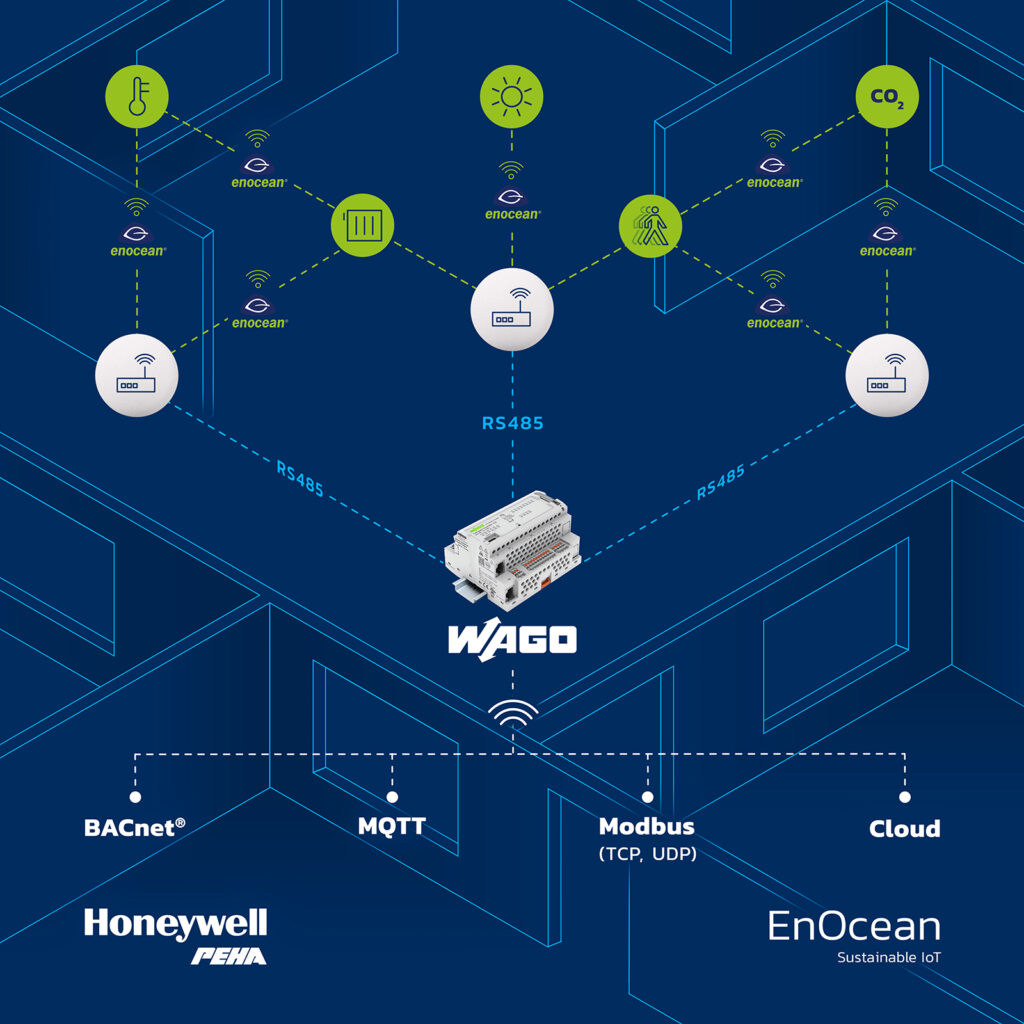Efficient and cost-effective solution for the energy transition in existing buildings
April 29, 2024
Smart building technology for energy transition: How WAGO and Honeywell PEHA make existing buildings GEG 2024 compliant using EnOcean technology.
The European Energy Performance of Buildings Directive (EPBD) has been in place since 2018. It promotes the use of renewable energies in the building sector and initiate an energy transition to strengthen climate protection. Efficient and cost-effective solutions are required to reduce energy costs in small and medium-sized buildings. WAGO now provides a wide range of sensor data for existing building management systems by combining its products and EnOcean technology. The solution in the 868 MHz radio range forms the basis for reliable data transmission. It´s optimized for building automation, even with very high sensor density.
Energy costs in small and medium-sized buildings must be reduced
According to the EPBD, the use of fossil fuels in buildings should be phased out by 2050 at the latest. “That sounds like a long time to outsiders, but it’s not for owners and landlords of small and medium-sized buildings. Here in particular, reducing energy costs through automation requires efficient and cost-effective solutions,” says Wolfgang Arndt. He is Senior Territory Manager, Electrical Products Germany at Honeywell PEHA. It is necessary to integrate a wide variety of sensor data into existing building management systems and ensure data transfer. At Light & Building 2024, Honeywell PEHA and its partner WAGO presented an innovative solution. It uses the proven EnOcean technology, which also enables the flexible use of various formats (BacNet Secure, MQTT or Cloud).
Universal solution with integration into an existing building ecosystem
“I am delighted that three market-leading partners have developed a powerful solution. After almost a year of intensive collaboration and development, the customer-oriented package can now be offered on the market,” says Wolfgang Arndt. Thanks to the combination of WAGO and Honeywell PEHA products and their connectivity, a wide variety of sensor data can be provided for existing building management systems based on secure EnOcean technology. In addition, the variety of PEHA devices now allows a wide range of sensor data to be transported to the WAGO Compact Controller via the PEHA gateway. Up to 16 gateways/antennas can be connected in parallel in a standard protocol (RS485). The use of antennas in addition to repeaters is no longer necessary. The antennas work bidirectionally and there is also a clear assignment of the various field devices to the antennas. “Thanks to the existing EnOcean library in the Compact Controller, customers can now create their project on a CODESYS basis as required. And, if necessary, they can even have a self-sufficient solution thanks to the integrated web server. However, integration into an existing building management system is essential in terms of efficiency, explains Holger Beland, Senior Area Sales Manager Industry at WAGO. With the solution approach from WAGO, Honeywell PEHA and EnOcean, data from the Compact Controller can be integrated into the building automation system using various connection options. Regardless of whether Modbus, BacNet Secure, MQTT or Cloud is used, the operator can decide on site which field level the data flows into in their building automation system. This does not force the operator to make a premature decision and the operator remains flexible until integration.

Ensuring compliance with all EPBD requirements guarantees added value for operators
“Another advantage for the operator is the fact that the EnOcean wireless technology can be installed during ongoing operation. And, it is maintenance-free, battery-free and environmentally friendly,” emphasizes Holger Beland. The efficient and cost-effective solution makes it easy to implement the requirements of the EPBD. It is especially valuable in small and medium-sized buildings and existing buildings that are not automated. Besides, installers can obtain it from specialist dealers. This project has once again demonstrated how new business areas can be created through functional cooperation between companies.


